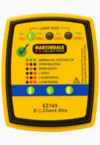Questions
A bog standard ring final circuit with a 30A amp rewireable fuse or 30A or 32A MCB at the fuseway:-
10 twin sockets on the ring.
1 twin socket spurred at the origin
1 twin socket spurred from the wiring on the ring
1 twin socket spurred from a socket on the ring
1 fused connection unit spurred from the ring and connecting 5 twin sockets on one radial leg.
Assuming a bog standard domestic circuit, floor area reasonable and end to end ring length reasonable and all wired in normal 2.5 T & E cable.
1/ Is that OK?
2/ Remove the ring itself and just leave the 1 twin socket on the radial.
3/ as in 2/ above but add 5 more twin sockets each on their own radial.
4/ Connect two more rings to the fuseway
assuming the fuseway accepts all of the conductors and is mechanically and electrically sound for all of the above options.
Which of those options are dangerous/potentially dangerous or unsafe? (and if so then why?)
A bog standard ring final circuit with a 30A amp rewireable fuse or 30A or 32A MCB at the fuseway:-
10 twin sockets on the ring.
1 twin socket spurred at the origin
1 twin socket spurred from the wiring on the ring
1 twin socket spurred from a socket on the ring
1 fused connection unit spurred from the ring and connecting 5 twin sockets on one radial leg.
Assuming a bog standard domestic circuit, floor area reasonable and end to end ring length reasonable and all wired in normal 2.5 T & E cable.
1/ Is that OK?
2/ Remove the ring itself and just leave the 1 twin socket on the radial.
3/ as in 2/ above but add 5 more twin sockets each on their own radial.
4/ Connect two more rings to the fuseway
assuming the fuseway accepts all of the conductors and is mechanically and electrically sound for all of the above options.
Which of those options are dangerous/potentially dangerous or unsafe? (and if so then why?)


